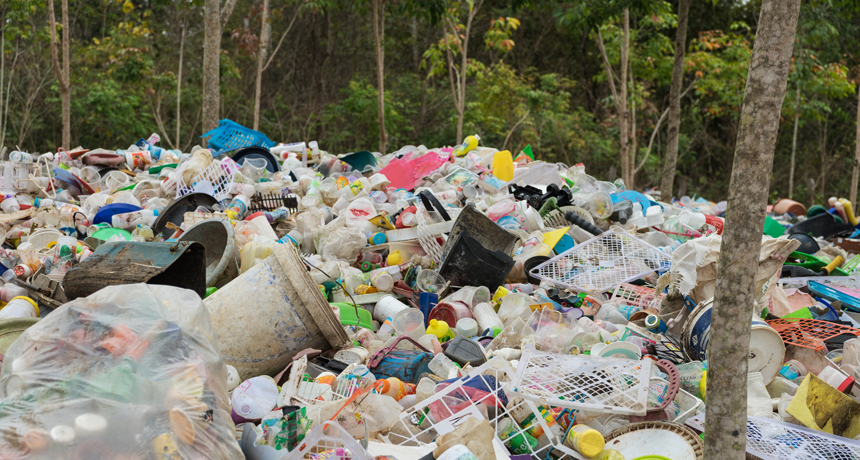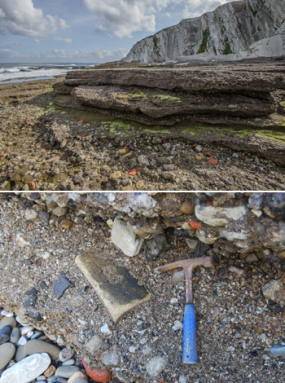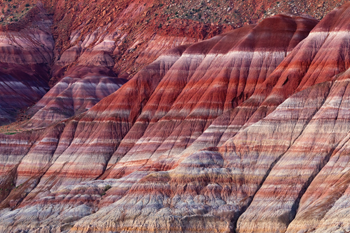Meet our trashy ‘technosphere’
People appear to have deposited a layer of waste across Earth’s surface that weighs 100,000 times more than all of humanity

All the waste that people generate is creating a huge new geologic layer. Scientists are calling it the technosphere.
pressdigital/iStockphoto
By Beth Geiger
Thirty trillion tons. That’s how much debris and disturbed land people have left behind across Earth’s surface, according to a new study. It’s a jumble of everything from plowed-up fields to ancient Roman ruins, plastic bags and those earbuds you lost last week.
And these findings amount to more than just trash talk. Poeple have created an entire new geologic layer, explains study leader Jan Zalasiewicz. He is a geologist at the University of Leicester in England. Plants and animals constantly re-use nutrients and wastes. But people aren’t so good at that, he observes. While we may recycle some materials, Zalasiewicz notes that most of our junk keeps piling up. “We don’t recycle like the biosphere does.”

The human-trash-laden layer atop Earth’s surface has a name: the technosphere. Scientists came up with that name around 2013. But this study is the first attempt to estimate its mass. Zalasiewicz and his colleagues used satellite images, maps and geological knowledge, such as topography (the shape of the Earth’s surface, for instance, or how deep mines extend) to come up with a very rough tally.
People appear to have deposited 30 trillion tons of this “stuff” on Earth’s surface. That’s spread over about 80 million square kilometers (31 million square miles). “It’s very approximate,” Zalasiewicz says of his team’s estimate. “But it’s a start.” Such a large amount surprised him, he says: “It’s about 100,000 times the weight of all [living] humans.” Zalasiewicz and colleagues published their estimates November 28 in Anthropocene Review.
The scientists did more than examine the size of the technosphere. They also estimated how many types of things this vast debris pile already includes. It’s similar to how biologists add up species of life. In biology, that’s called diversity.
The technosphere’s “stuff,” too, is diverse. There are more types of these materials than there are species of life, the researchers have concluded . Take cell phones. Think of cell phones as a family, akin to the role people share in the family Hominidae. “Smartphones may be a subfamily within that,” Zalasiewicz explains. A brand of cell phones might be a genus. “And a particular make of that brand, a little different in shape than the others, will be a species,” he says. Accounting that way for all types of litter and trash makes for a lot of different kinds of stuff.
Just another layer
Over time, the technosphere may become sedimentary rock. That’s the type that forms when sediments, such as sand or mud, become buried by newer sediments. Eventually, pressure and heat hardens those layers into rock. Much of Earth’s complex, 4.6-billion-year history is recorded in such rock. The oldest rocks lay on the bottom and the youngest at the top. Like chapters in a book, each layer tells a story. The clues they contain — such as fossils, ancient beach deposits or ash from long-extinct volcanoes — reveal something about the geologic time in which they were deposited.

Gradually, the technosphere is becoming just another layer with its own stories to tell. Like older rocks, it is also associated with a period of geologic time. That time is called the Anthropocene. This age includes all the years that people have been altering Earth’s surface. Exactly when the Anthropocene started is still under debate.
“The term ‘Anthropocene’ is a concept,” explains Lucy Edwards. A geologist at the U.S. Geological Survey in Reston, Va., she helps name geologic features. Naming our time the Anthropocene, she says, “recognizes that humans are really changing the environment — and to a large extent.” The technosphere is a good way to describe the physical effects of that, she says. And even if Zalasiewicz’s estimate of the technosphere’s mass is “just in ballpark,” Edwards says it makes a good point for discussinghumanity’s impacts.
Future file
Today, the technosphere is mostly a loose mix of everything from garbage, roads and buildings to churned-up soil. But that will change in the distant future as it turns into a geologic layer. “Far-future geologists will have a huge set of puzzles on their hands,” Zalasiewicz predicts.
Bricks, plastic and concrete will provide evidence that people were here, long after they have vanished, Zalasiewicz’s team imagines. Food waste tossed into landfills will have turned to black carbon. There will be mine shafts, layers of iron where metal has rusted to dust, maybe even a few smudges from petrified ball point pens. Former cities will be a confusion of concrete chunks, building parts and countless odds and ends.
Some clues will make unraveling this geologic puzzle a little easier. For starters, there will be plenty of techno-fossils. “All those things that people make end up in the ground, just like fossils,” says Pat Holroyd. As a paleontologist at the University of California Museum of Paleontology in Berkeley, she studies fossil animals.
Even in places where there are no buildings, roads or landfills, humans have left their mark. For example, she notes, farms and factories leave a chemical signature of humans’ impacts.
World War II created an especially clear layer that marks the middle of the 20th century. For example, in Berlin, Germany, rubble from bombed buildings was pushed into mounds. Fourteen of those mounds still persist, Zalasiewicz’s team notes. The biggest, a hill named Teufelsberg (TOY-fels-burg), is now a pile of debris. It measures up to 80 meters (262 feet) thick and covers an area equivalent to 200 football fields.
The technosphere continues to grow. And everyone contributes to it. A plastic water bottle, the old socks you finally tossed, a broken cell phone. “All the stuff we make is evolving fast and piling up fast,” notes Zalasiewicz.
Geologists of the future will also find plenty of index fossils in the technosphere. Past ones are from organisms that were widespread but only existed for a very short time. Geologists use index fossils to figure out the age of the rocks in which they are found. A nail might not make a very good index fossil in the technosphere, since nails have been in use for centuries. But a smashed iPhone 7 would pin the date of some layer down to 2016 or later.







